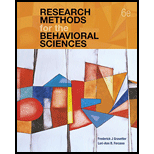
In addition to the key words, you should also be able to define each of the following terms:
Descriptive research strategy.
Behavioral observation.
Habituation.
Behavior categories.
Inter-rater reliability.
Frequency method.
Duration method.
Interval method.
Time sampling.
Individual sampling.
Likert scale.
Anchors.
Response set.
Nonresponse bias.
Interviewer bias.
Idiographic approach.
Nomothetic approach.
Define the following terms
Descriptive strategy, Behavioural observation, Habituation, Behaviour Categories, Inter-rater reliability, Frequency method, Duration Method, Interval Method, Time sampling, Event Sampling, Individual Sampling, Likert Scale, Anchors, Response set, Nonresponse bias, Interviewer bias, Idiographic approach, and Nomothetic approach.
Explanation of Solution
Descriptive strategy:
It involves measuring a variable or set of variables as they exist naturally. Unlike the other research strategies descriptive strategy is not concerned with relationships between variables but rather with the description of individual variables. The goal is to describe a single variable or to obtain separate descriptions for each variable when several are involved. This strategy is extremely useful as preliminary research.
Behavioural Observation:
Behavioural observations are used in the field of psychology to observe, describe, explain, predict and sometimes correct behaviour. Behavioural assessment can be useful in clinical, educational and corporate settings.
Habituation:
Habituation is a psychological learning process wherein there is a decrease in response to a stimulus after being repeatedly exposed to it. This concept states that an animal or a human may learn to ignore a stimulus because of repeated exposure to it.
Behaviour Categories:
behavioural categories are behaviours that might be observed in an observation study. these are behaviours and not emotions so laughing, smiling or crying would be behaviours but happiness and sadness wouldn't because they are emotions.
Inter-rater Reliability:
During the observation period, normally only one individual observes and records behaviours using the set of behavioural categories as a guide. To establish reliability, it is required that two or more individuals observe and record simultaneously during some of the observation periods. The degree of agreement between the two observers is then computed, either by computing a correlation between the scores for the two observers or by computing a proportion of agreement ranging from 1 as perfect agreement to 0 as no agreement as a measure of inter-rater reliability.
Frequency Method:
It involves counting the instances of each specific behaviour that occur during a fixed time observation period.
Duration Method:
It involves recording how much time an individual spends engaged in a specific behaviour during a fixed time observation period.
Interval Method:
It involves dividing the observation period into a series of intervals and then recording whether a specific behaviour occurs during each interval.
Time Sampling:
It involves observing for one interval, then pursing during the next interval to record all the observations. The sequence of observe-record-observe-record is continued through the series of intervals.
Event Sampling:
It involves identifying one specific event or behaviour to be observed and recorded during the first interval, then shifting attention to a different event or behaviour during the second interval, and so on, for the full series of intervals.
Individual Sampling:
It involves identifying one participant to be observed during the first interval, then shifting attention to a different individual for the second interval and so on.
Likert Scale:
The rating scale presented as a horizontal line divided into categories so that participants can simply circle a number or mark an X at the location corresponding to their response. This type of rating scale is Likert Scale.
Anchors:
There is no rule for labelling the categories. The opposite extremes are identified with verbal labels called anchors that establish the endpoints of the scale.
Response Set:
Whenever questions in a series all have the same choices for responding, participants tend to use the same response to answer all of the questions. This tendency is called a Response set.
Nonresponse bias:
It means that the people who complete surveys are a self-selected sample that may not be representative of the population and it is difficult to control the sample of respondents, this is called as Nonresponse bias.
Interviewer bias:
Where a researcher has direct contact with participants, even over telephone, there is a risk that the researcher will influence their natural response, this is known as Interviewer bias.
Idiographic approach:
The idiographic approach describes research goals that focus on the individual rather than focusing on or generalizing individual results to the entire population. Idiographic research focuses on the uniqueness of the individual rather than developing theories of behaviour than can be generalized to the population.
Nomothetic approach:
A nomothetic approach generalizes individual results to the entire population. A nomothetic approach used in personality psychometrics like the Big Five personality traits uses personality characteristics and generalizes them from the individual to the population as a whole.
Rework: Please look for the plagiarism in the solution provided. Plagiarism is not allowed.
Want to see more full solutions like this?
Chapter 13 Solutions
Research Methods for the Behavioral Sciences (MindTap Course List)
 Glencoe Algebra 1, Student Edition, 9780079039897...AlgebraISBN:9780079039897Author:CarterPublisher:McGraw Hill
Glencoe Algebra 1, Student Edition, 9780079039897...AlgebraISBN:9780079039897Author:CarterPublisher:McGraw Hill Holt Mcdougal Larson Pre-algebra: Student Edition...AlgebraISBN:9780547587776Author:HOLT MCDOUGALPublisher:HOLT MCDOUGAL
Holt Mcdougal Larson Pre-algebra: Student Edition...AlgebraISBN:9780547587776Author:HOLT MCDOUGALPublisher:HOLT MCDOUGAL College Algebra (MindTap Course List)AlgebraISBN:9781305652231Author:R. David Gustafson, Jeff HughesPublisher:Cengage Learning
College Algebra (MindTap Course List)AlgebraISBN:9781305652231Author:R. David Gustafson, Jeff HughesPublisher:Cengage Learning



